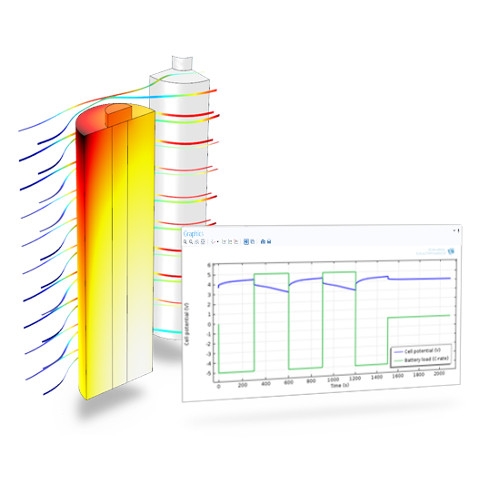Schedule a Call Back
Batteries And Fuel Cells Module
Batteries And Fuel Cells Module
Comsol Multiphysics Pvt Ltd offers Batteries And Fuel Cells Module. Batteries and fuel cells are being asked to perform in more challenging environments, with greater energy densities or power efficiencies, over longer lifetimes. These requirements are placing more pressure on these industries, and modeling and simulation is fast becoming one of the necessary tools for developing, designing, optimizing, and ensuring quality and safety of batteries and fuel cells during operation. Examples of systems that may be studied include lead-acid batteries, lithium-ion batteries, nickel metal-hydride batteries, solid oxide fuel cells (SOFCs), direct-methanol fuel cells (DMFCs), and proton exchange membrane fuel cells (PEMFCs). The Batteries & Fuel Cells Module models the underlying electrochemical behavior in the electrodes and electrolytes of batteries and fuel cells. It allows you to investigate their performance for different operating conditions, design configurations, and deterioration due to different aging mechanisms. With this add-on module, you can simulate characteristics such as the transport of charged and neutral species, current conduction, fluid flow, heat transfer, and the nature and driving forces of electrochemical reactions at planar and in porous electrodes. Using this understanding of these characteristics, you can design and optimize the geometries and material choices of your system's electrodes, separators, membranes, electrolyte, and current collectors and feeders with respect to performance, thermal management, and safety. The Batteries & Fuel Cells Module is the only simulation software that can be used freely for modeling all types of fuel cells and batteries, with the most robust features for simulating all varieties of electrochemical behavior.
Product & Technology News
- Primary, Secondary, and Tertiary Current Distribution interfaces for current balances in the electrolyte and pore electrolyte for free and porous media
- Formulations for electroneutrality, supporting electrolyte, or Poisson's equation for the charge balance equations
- Nernst-Planck equations in dilute and concentrated solutions
- Nernst-Einstein equation for relating mobility and diffusivity in electrolytes
- Maxwell-Stefan equation for transport in gases including homogeneous and electrochemical reactions as sources and sinks
- Ohm's law and conservation of current in the electrodes
- Nernst equation for equilibrium potential and concentration overpotential
- Stoichiometry and Faraday's law for automatic coupling of material and current balances to electrode reactions
- Electrode kinetics accounting for activation and concentration overpotential
- Electrocatalysis including adsorption and desorption
- Butler-Volmer and Tafel equations for predefined kinetics
- Solid electrolyte interface description (SEI) including a model variable for varying the interface thickness depending on operating conditions
- Intercalation of species in electrode particles
- Predefined formulations for porous electrodes and GDEs, including effects of porosity and tortuosity using Bruggeman relations for effective media
- Agglomerate models and thin film models for describing transport in pore electrolytes in porous electrode and GDEs
- Porosity variation due to dissolution of electrode material during operation by including porosity as a model variable coupled to the charge transfer reactions
















